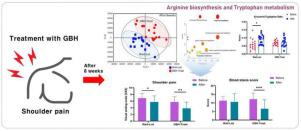Phytomedicine ( IF 6.7 ) Pub Date : 2022-06-09 , DOI: 10.1016/j.phymed.2022.154248 Mi Mi Ko 1 , Jeeyoun Jung 1 , Jung-Eun Lee 2 , Seon Mi Shin 3 , Hyun-Kyung Sung 4 , Ho-Yeon Go 3 , Soobin Jang 1

|
Background: In Korea, Gyejibongnyeong-Hwan (GBH), a herbal decoction used to treat blood stasis (BS), is widely used to treat shoulder pain in clinics. Nevertheless, the therapeutic mechanism of GBH in alleviating shoulder pain has not yet been elucidated.
Purpose: In this study, we applied mass spectrometry-based metabolomics to explore the therapeutic mechanism of GBH in BS-induced shoulder pain.
Study design: We conducted a two-center, randomized, wait-list controlled pilot trial to explore the therapeutic effect of GBH on shoulder discomfort related to BS.
Methods: A total of 40 participants with shoulder pain were randomly assigned to either the immediate treatment (GBH-Treat; n = 20) or waiting treatment (Wait-List; n = 20) group. A non-targeted metabolomics approach was then applied to investigate the therapeutic mechanism of GBH.
Results: After 8 weeks of treatment, the visual analog scale (VAS) scores for shoulder pain decreased significantly in the GBH-Treat and Wait-List groups compared with baseline VAS scores (p = 0.004 and p = 0.013, respectively). However, the VAS and BS scores were significantly more reduced in the GBH-Treat group than in the Wait-List group. The plasma metabolic pattern between GBH-Treat and Wait-List groups also differed significantly, which was shown by the score plot of a partial least-squared–discriminant analysis (R2 = 0.806 and Q2 = 0.229, p = 0.016). Arginine, bilirubin, carnitine, glutamine, maltol, mystic acid, N,N dimethylarginine, trimethylamine N-oxide, valine, kynurenine, and linoleic acid significantly contributed to the different metabolic patterns between the GBH-Treat and Wait-List groups (all p < 0.05).
Pathway analysis revealed that these metabolites were involved in arginine biosynthesis and tryptophan metabolism, which are related to pain generation and transmission. We also confirmed that the ratio of kynurenine to tryptophan, one of the indicators for chronic pain and neuro-inflammation, was significantly lower in the GBH-Treat group than in the Wait-List group (p = 0.02).
Conclusion: These results demonstrated that GBH may be a potential treatment option for shoulder pain, and it acts by regulating metabolic patterns. In particular, our study provides evidence for the use of GBH treatment for patients with should pain caused by BS, and we believe that our findings can provide evidence for precision medicine based on traditional Chinese medicine (TCM) or traditional Korean medicine (TKM). We also verified that metabolomics studies provide comprehensive understanding of herbal decoctions in TCM or TKM.
中文翻译:

Gyejibongnyeong-Hwan 治疗肩痛的代谢组学分析:一项随机、等待名单对照试验
背景:在韩国,用于治疗瘀血 (BS) 的草药汤剂 Gyejibongnyeong-Hwan (GBH) 在临床上被广泛用于治疗肩痛。然而,GBH 减轻肩痛的治疗机制尚未阐明。
目的:在本研究中,我们应用基于质谱的代谢组学来探索 GBH 在 BS 引起的肩痛中的治疗机制。
研究设计:我们进行了一项两中心、随机、等待名单对照试验,以探索 GBH 对与 BS 相关的肩部不适的治疗效果。
方法:共有 40 名肩痛参与者被随机分配到立即治疗(GBH-Treat;n = 20)或等待治疗(Wait-List;n = 20)组。然后应用非靶向代谢组学方法研究GBH的治疗机制。
结果:治疗 8 周后,与基线 VAS 评分相比,GBH-Treat 和 Wait-List 组肩痛的视觉模拟评分 (VAS) 评分显着下降(分别为p = 0.004 和p = 0.013)。然而,GBH-Treat 组的 VAS 和 BS 评分明显低于等候名单组。GBH-Treat 和 Wait-List 组之间的血浆代谢模式也有显着差异,这可以通过偏最小二乘判别分析的得分图 ( R 2 = 0.806 和Q 2 = 0.229, p = 0.016)。精氨酸、胆红素、肉碱、谷氨酰胺、麦芽酚、肉豆蔻酸、N,N 二甲基精氨酸、三甲胺 N-氧化物、缬氨酸、犬尿氨酸和亚油酸显着促进了 GBH-Treat 和 Wait-List 组之间的不同代谢模式(所有p < 0.05)。
通路分析表明,这些代谢物参与了精氨酸生物合成和色氨酸代谢,与疼痛的产生和传递有关。我们还证实,犬尿氨酸与色氨酸的比率(慢性疼痛和神经炎症的指标之一)在 GBH-Treat 组中显着低于 Wait-List 组(p = 0.02)。
结论:这些结果表明,GBH 可能是肩痛的潜在治疗选择,它通过调节代谢模式起作用。特别是,我们的研究为使用 GBH 治疗 BS 引起的疼痛患者提供了证据,我们相信我们的研究结果可以为基于中医 (TCM) 或传统韩医 (TKM) 的精准医学提供证据。我们还证实,代谢组学研究提供了对中药或传统知识中草药汤剂的全面了解。











































 京公网安备 11010802027423号
京公网安备 11010802027423号